Very cold war. Special Operations in the Arctic
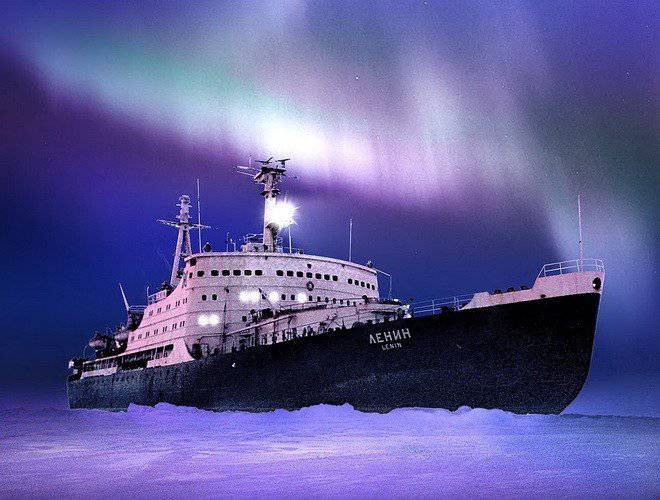
Outlines of a peaceful Soviet tractor emerged from the snowy shimmering haze. Half-wrapped with snow, the tracked vehicle was forever stuck in a deep crack. The next find was a hydrological winch, rusted and frozen into ice. The calculations were fully confirmed - the staff left the station in a big hurry, empty barrels, boards and pieces of equipment were scattered everywhere. The creeping hummocks nearly swallowed the diesel power station and destroyed the improvised runway on the cleared ice. It became clear why the polar explorers did not manage to evacuate the equipment.
Crunching with snow, Leonard Le'Shack cautiously approached the radio tower. There could be no doubt - they managed to find SP-8! The legendary Soviet scientific station now met new inhabitants: a smiling James Smith appeared between the buildings. The second participant of the secret expedition examined the abandoned base with no less interest.
- Leo, are you alright?
- Everything is OK
- It looks like we have a lot of work to do.
“Yeah, Le'Shack barely squeezed his teeth, shivering in the cold wind.
The lights of the “Flying Fortress” swayed in the gloomy sky — throwing off the last bale of equipment, the plane went back to Point Barrow. Below, on the ice, in the middle of the deadly Arctic cold, two living people remained. Coordinates 83 ° north latitude, 130 ° west longitude. Operation Coldfeet has begun.
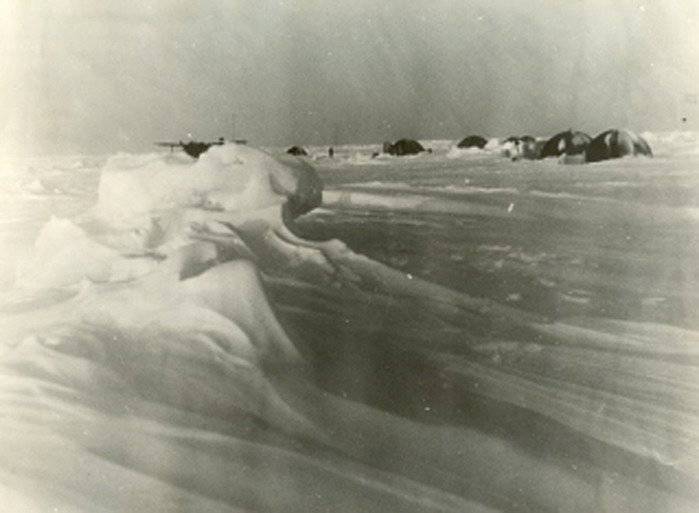
Having hoisted the entrance door with a crowbar, the US Navy lieutenant Le'Shack and polar explorer James Smith entered one of the shield houses in the North Pole-8 area. The beam of the lantern rested against a tear-off calendar hanging on the wall - 19 March 1962 of the year. The interior of the Soviet station did not cause much surprise: a chessboard, a stationery set, a stack of books on a rickety shelf, nothing interesting - fiction. Sooty potbelly stove, sink, soft carpet. Cozy. In some places on the walls were posters with the image of Lenin and strong, taut Komsomol members. But the main thing is that the prefab house was installed on runners, which allowed it to be quickly moved across the ice when dangerous cracks appeared nearby.
- Here will be our lair, James
- Yeah. Look, the Russians grew something here, - both polar explorers came to the window. On the windowsill there was a box with earth, among the frozen lumps of soil, dry stalks of onions stuck out. The Arctic ruthlessly killed and sucked the life of the unfortunate plants.
“A sad sight,” Le'Shack concluded.
Having dragged their gear into the house, and having barricaded the door just in case, the Americans were forgotten in a deep sleep, reliving all the events of a difficult day. Landing on the ice, an abandoned Soviet station and the endless Arctic desert - impressions last for a lifetime!
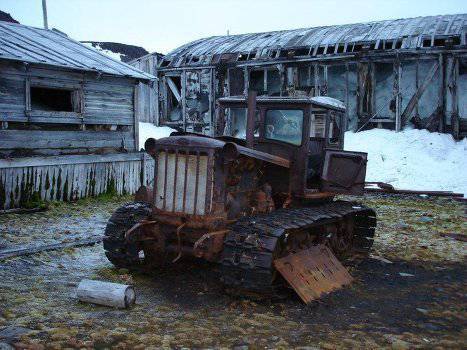
On the morning of May 29, the 1962 of the year, after a quick bite, the explorers set about to complete their tasks. While Le'Shack fiddled with the radio station, Smith cleared the meteorological booth. He got rich trophies: a whole set of thermometers (mercury, alcohol, “dry”, “wet”, maximum and minimum), a hygrometer, a thermograph and a hydrograph with a clock mechanism. Already leaving the meteorological site, the American grabbed the anemometer (a device for measuring wind speed) and Wildv weather vane.
Packing the first wardrobe trunk with the captured equipment, Smith headed towards the radio room ...
“Made in USSR,” Le'Shak echoed enthusiastically, “it was enough to replace the power source as it came to life and earned it at the reception.
The sound of music came from black headphones - the station was tuned to Soviet radio stations in the HF band.
“Okay, now let's get in touch with Barrow.” It is necessary to report on the situation.
... The life of polar explorers ran its course. Le'Shak and Smith systematically inspected the station, dismantled and packed the most interesting equipment into wardrobe trunks, searched for any written evidence - specialized literature, letters, notebooks. In the mess-room, a wall newspaper was found where Romanov, the last head of the SP-8 station, just in case noted the date and reasons for the station’s evacuation, as well as an appeal to the Arctic and Antarctic Research Institute in Leningrad. In another residential area, the Americans found a notebook with secret codes - as it turned out, just a recording of an extramural chess game between employees of SP-8 and the Moscow River Shipping Company.
A considerable surprise was delivered by one of the shield houses - a real Russian bathhouse with an improvised “snow melter” and a pump for pumping water showed up inside!
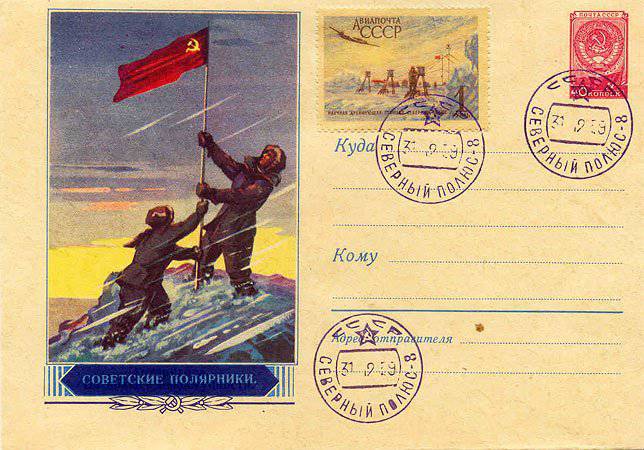
However, in their reports, Le'Shack and Smith noted a huge contrast between the ascetic interior of the station’s premises and the stunning array of high-end scientific equipment: atmospheric weather probes, astronomical instruments, radio communications, navigation, oceanographic instruments: an automated current recorder, deep-sea science complexes ...
Then, when these things fall into the United States, naval intelligence (Office of Naval Intelligence) experts will make an unexpected conclusion: Soviet scientific instruments have an exceptionally high level of technological performance, and, moreover, are production models.
But the main find was made in the evening on the first day of presence at the abandoned base - the Americans found that the SP-8 electric generators were installed on special damping devices. Why such measures to ensure low noise and vibration? There could be only one explanation - an underwater sonar beacon or a submarine tracking system was installed somewhere nearby. Official story It does not give a clear answer - Le'Shak and Smith were able to find something similar on the SP-8 or top-secret equipment was removed in advance by Soviet polar explorers.
The third day, the last one, was spent on an abandoned polar station. Slowly destroying the traces of their stay, and collecting voluminous bales of trophies (more than 300 photos, 83 documents, 21 samples of instruments and tools!), Leonard Le'Shack and James Smith prepared for evacuation. A radio operator with Point Barrow confirmed the departure of the search and rescue vehicle. Now we just have to wait ...
The Arctic made its own adjustments to the plans of the people - it was not possible to evacuate the reconnaissance group that day. For two days in a row, the Americans pulled out their trunks on the ice and waited for the “Flying Fortress”, sometimes they even heard the roar of engines - alas, a sharp deterioration in the weather every time disrupted the operation. It was getting annoying.
Finally, on the evening of July 2, the cargo was safely delivered on board the aircraft. The turn of Leonard Le'Shack ...
The Americans had a nontrivial task: to deliver cargo and people from the surface of the ice to the board of an airplane racing in the clouds. Landing on the ice is excluded: "Flying Fortress" will break on the multimeter pile of hummocks. To clear the runway by two people, without the use of special equipment - the task is completely unrealistic. The helicopters capable of refueling in the air and overcoming 1000 km over the icy desert did not exist in those years. Available was only the "Flying Fortress" and the same ancient naval patrol aircraft P-2 "Neptune". What to do?
Leonard Le'Shack looked at the proposed solution with apprehension and disbelief. Was - was not! He still has no choice. Le'Shack hooked the hook to his belt and prepared to inflate a balloon with helium.
Above it was heard the growing roar of engines - “Flying Fortress” broke through the lower edge of the clouds and got ready to lift the polar explorers. The navigator and radio operator, leaning out into a transparent blister, watched with interest the two cranks below.
- Uh, you're there! Stir! - The crew of the “fortress” joyfully welcomed Le'Shack and Smith.
Le'Shak sighed heavily and blew a balloon, which immediately broke out of his disobedient hands from the cold and disappeared into the gray sky. A thin nylon rope, the other end of which was attached to the Le'Shack belt, flew after the ball up. Finally, the 150-meter cable twitched and pulled like a string. A sharp gust of wind knocked the prop out from under his feet — a man slid helplessly across the ice, hitting his knees and hands on the sharp edges of the hummocks. And then it exploded in such a way that Le'Shak darkened his eyes for an instant ...
Over the Arctic, at dusk of a polar day a living man flew. Without the aid of parachutes and wings, at a speed of 130 knots per hour, Leonard Le'Shack tumbled in the cold Arctic air, opposing gravity to levitation.
Ice cold frost covered his face, burning wind penetrated into the lungs, threatening to freeze from the inside. The air attraction lasted for six and a half minutes, while Le'Shack, who was suffocatingly hanging on a rope, was lifted up and hoisted to board the plane.
Smith's ascent was easier - when he saw the wind dragging his comrade across the ice, he kept to the peaceful Soviet tractor until the last moment - finally, the plane “hooked up” the rope and pulled it aboard through the loading ramp.
***
In August, 1962 published the latest edition of the US Naval Intelligence magazine ONI Review under the heading "Operation Coldfeet: An Investigation of the Abandoned Soviet Arctic Drift Station NP 8" (for internal use). The article reflected in detail all the vicissitudes of the expedition to the abandoned polar station SP-8, the cost of the special operation and the results achieved. The Americans were surprised by the scale of Soviet Arctic research, the US Navy was able to get acquainted with the products of Soviet instrument making; Confirmations were received about the use of drifting scientific stations "North Pole" for military purposes, and the CIA made unequivocal conclusions about the state of Soviet science and industry. It was recommended to continue work related to the "visit" of Soviet sites in the Arctic.
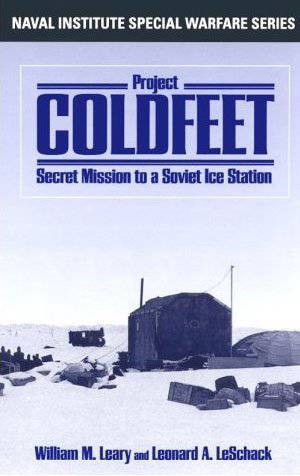
The ethical moment did not excite the Americans - by the time of the “visit”, the red flag of the USSR had already been lowered above the abandoned station. According to international maritime law, any “no-man’s” object is considered a “prize” and becomes the property of the finder.
As for the strange "evacuation" of polar explorers, James Smith and Leonard Le'Shak using a nylon cable and a balloon - this is just Fulton's surface-to-air recovery system, adopted by the CIA and the US Air Force in the distant 1958 year . The idea is simple: a person fastens a special harness on himself, a cable clings to his belt, the other end of which is attached to a balloon. The ball does not play any role in the direct lifting of a person - his only task is to stretch the cable in an upright position.
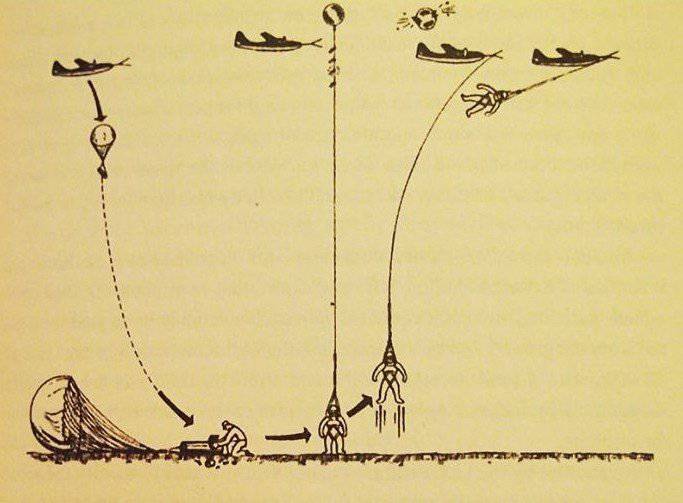
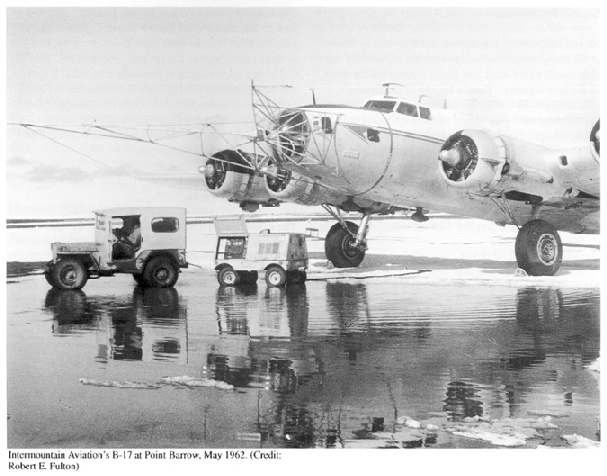
On the nose of the car is a clearly visible device for gripping the cable
The second element of the system is a low-speed transport aircraft (based on “Flying Fortress”, P-2 “Neptune”, S-2 “Tracker” or C-130 “Hercules”) with folding “mustaches” mounted on the nose. The plane approaches the target at a speed of 200-250 km / h so that the cable is exactly in the “whisker” solution: when the rescue plane “cuts” the cable, the crew selects the payload using a winch. Five minutes of nightmare - and you're on board. Witty and simple.
As experiments have shown, the overload in this case is not so great as to seriously cripple the person, moreover, the “jerk” is partially compensated by the elastic properties of the nylon rope.
Currently, with the development of rotary-wing machines, the system has lost its relevance. However, it is still used by the US Air Force for emergency evacuation of downed pilots and special forces. According to the Americans, Fulton's "air hook" is no more dangerous than the usual parachute jump. Not a bad decision to get a person out of any trouble, including from the Arctic ice floe.
Finale
The uninhabited “country of icy horror” became the scene of intrigue and serious confrontation between the USSR and the USA during the Cold War. Despite the unfit living conditions, there were quite a few “dual-use” military facilities and polar stations on the territory of the Arctic.
Russian polar explorer Arthur Chilingarov recalled how he was surprised a lot during the “friendly visit” of an abandoned American station in 1986, despite the “research status” of the facility, all equipment and equipment were marked with US Navy (US Navy).
The former head of the SP-6 station, Nikolay Bryazgin, described how their improvised runway on cleared ice was used to test the landing of the Tu-16 strategic bomber as a “jump airfield”.
At the polar station SP-8, investigated by Leonard Le'shak and James Smith, there was indeed special equipment of the Soviet Navy. Here also worked a group of the Kiev Institute of Hydraulic Instruments - the Naval the fleet required a network of sonar beacons to orient nuclear submarines under ice.
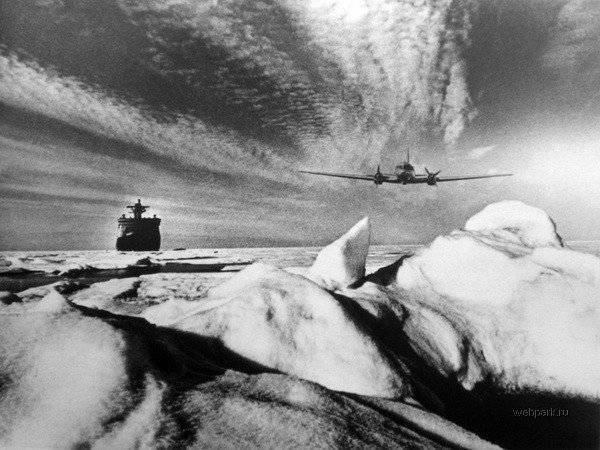
According to the stories of the North Pole-15 employees, nuclear submarines repeatedly surfaced in the polynya near their station — the sailors continued to test the underwater sonar orientation system.
At first, military specialists peacefully got along at the same station with scientists, however, soon misunderstandings arose - regular oceanographic surveys, accompanied by ice drilling and immersion of deep-water instruments, interfered with the work of special military equipment. We had to urgently organize a new station in 40 kilometers from the main one. The secret object received the cipher SP-15F (branch) - here passed the test equipment to detect enemy submarines.
But the main gift to submariners from polar explorers is a map of the bottom of the Arctic Ocean. Long years of hard work, countless measurements in all areas of the Arctic. Twenty years ago, the map was declassified and presented to the whole world as the wealth of Russia - a convincing argument that eloquently testifies to Russia's right to develop deposits at the bottom of the Arctic Ocean.
The source of information on Soviet dual-use stations is Kommersant-Vlast magazine, issue 21 from November 2000.
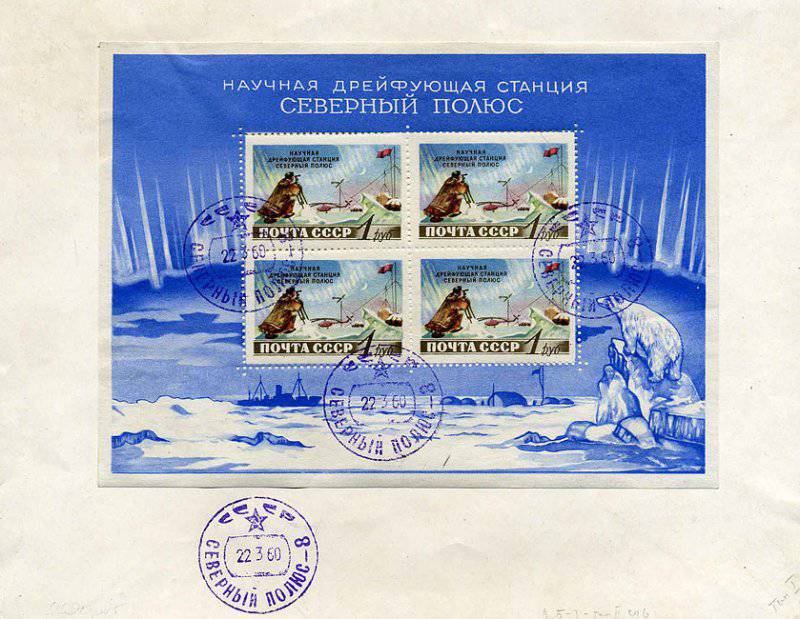
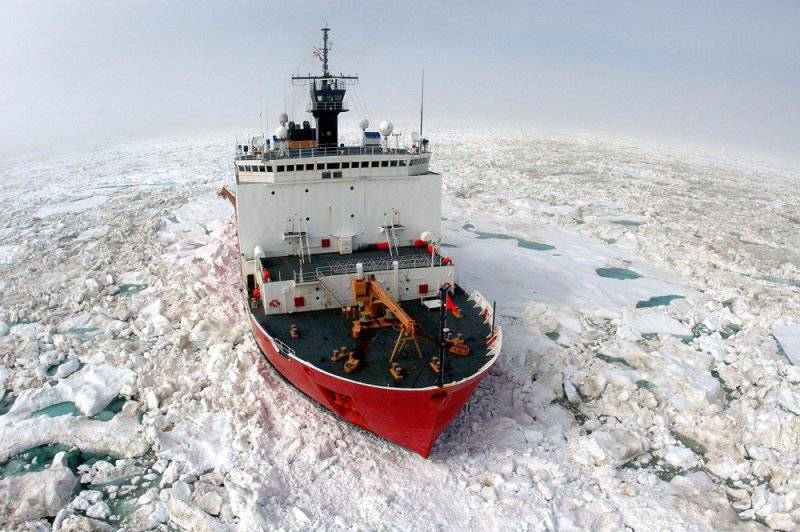
Information